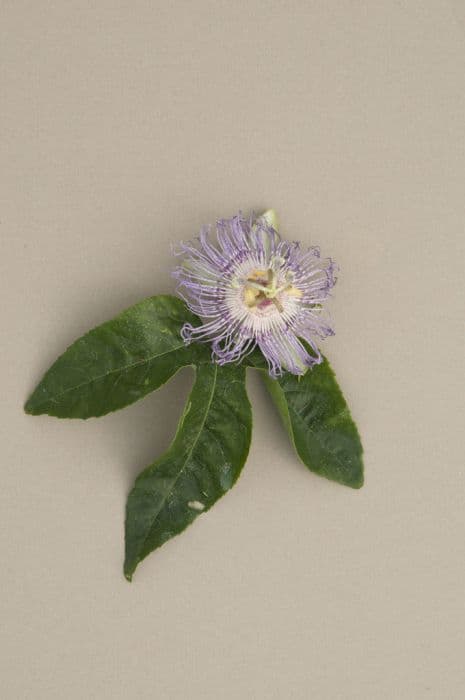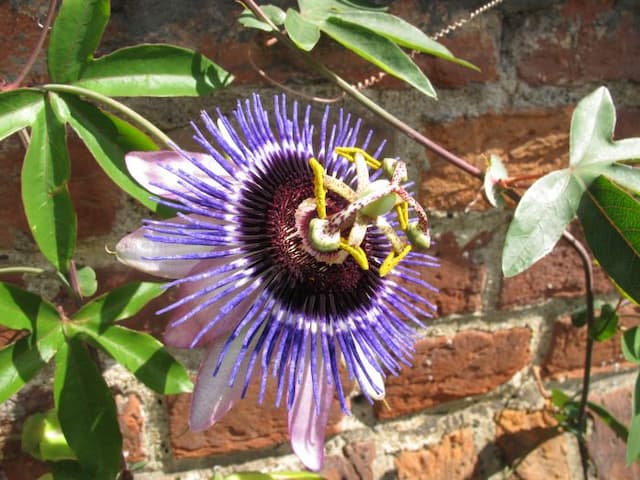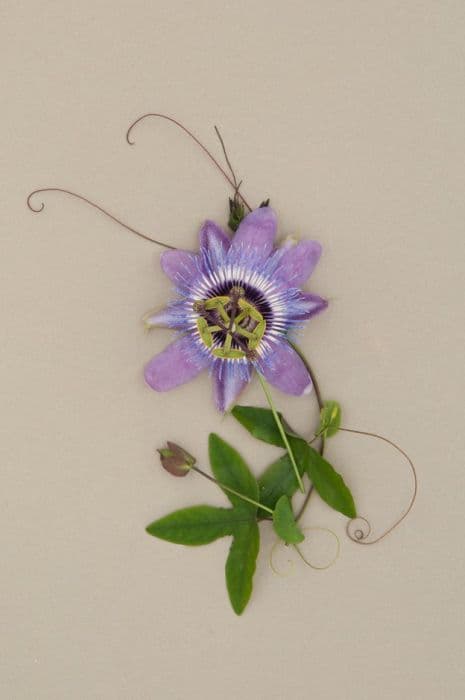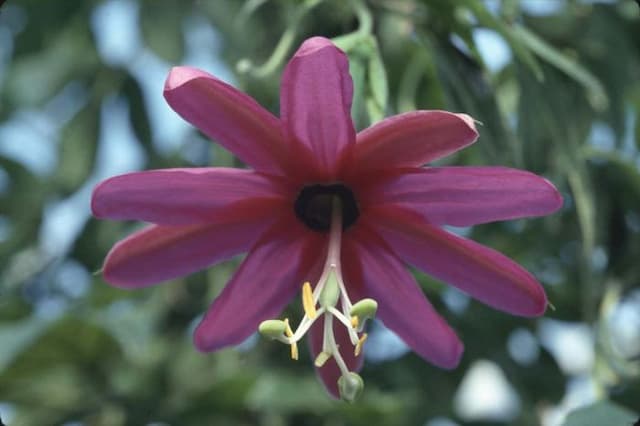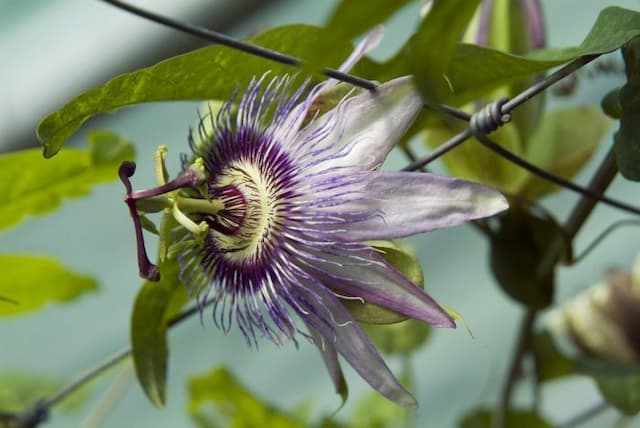Victoria Passion Flower Passiflora × violacea 'Victoria'

ABOUT
The Passiflora × violacea 'Victoria', commonly known as the Victoria Passion Flower, is a stunning climber known for its exceptional flowers and foliage. The plant boasts deeply lobed, dark green leaves that create a lush backdrop for its blossoms. Each exquisite flower features a captivating combination of colors, typically showcasing purple and white hues that effortlessly blend together. The crown consists of a filigree of purple filaments that surround the central structures of the flower, adding to the complexity and allure of the bloom. These striking flowers are not only notable for their beauty but also for their size, making them standout features in the garden. After the flowering period, the Victoria Passion Flower may produce egg-shaped fruits. These fruits offer an additional decorative aspect, although they are more noted for the flowers themselves. The eye-catching appearance of this passion flower variety makes it a popular choice for gardeners who want to introduce vertical interest and a tropical flair to their outdoor spaces. It thrives on structures such as trellises, fences, and arbors, weaving its way upwards and creating a vivid display of color and texture. With its dramatic flowers and attractive foliage, the Victoria Passion Flower is a delightful specimen that can transform any garden space into a visually engaging sanctuary.
About this plant
 Names
NamesFamily
Passifloraceae
Synonyms
Victoria Passion Flower, Red Passion Flower
Common names
Passiflora × violacea 'Victoria'.
 Toxicity
ToxicityTo humans
Passionflower, including the variety Passiflora × violacea 'Victoria', is generally considered to have a low toxicity level to humans. Most species in the Passiflora genus are not known to be toxic, and some are used for edible fruits or medicinal purposes. However, some individuals may experience mild adverse reactions if they consume parts of the plant, especially in large quantities. Symptoms of ingesting parts of the plant that could potentially lead to negative effects include gastrointestinal upset, such as nausea, vomiting, and diarrhea. Some species of Passiflora may contain cyanogenic glycosides, which can release cyanide in the body, but such toxicity is rare and generally associated with ingestion of large amounts of plant material. As with any plant, individual sensitivities can vary, and it is generally recommended to avoid consuming any part of ornamental plants.
To pets
Passionflower is considered to have a low level of toxicity to pets as well. The variety Passiflora × violacea 'Victoria' is unlikely to be harmful to pets in small quantities. However, as with humans, consuming parts of the plant in large amounts could potentially cause mild gastrointestinal distress in animals, such as vomiting or diarrhea. While serious toxicity is rare, pets may be more sensitive to certain plant compounds than humans, and it is advisable to prevent pets from ingesting the plant to avoid any potential adverse effects. If you suspect your pet has ingested a large amount of passionflower and is showing symptoms of distress, it is best to consult a veterinarian.
 Characteristics
CharacteristicsLife cycle
Perennials
Foliage type
Evergreen
Color of leaves
Green
Flower color
Mixed
Height
10 feet (3 meters)
Spread
6 feet (1.8 meters)
Plant type
Climber
Hardiness zones
9
Native area
South America
Benefits
 General Benefits
General Benefits- Attractive Flowers: The Passion Flower has unique, ornate flowers that add an exotic touch to gardens and landscapes.
- Pollinator Friendly: It attracts bees, butterflies, and other beneficial insects, providing essential support for local ecosystems.
- Fruit Production: Some varieties of Passion Flower produce edible fruits that can be used in cooking and beverages.
- Fast Growing: It can quickly cover trellises, arbors, and fences, providing quick greenery and shade where needed.
- Adaptability: Passion Flower can adapt to various soil types, making it easier to grow in different garden conditions.
- Diversity: Numerous cultivars and hybrids like 'Victoria' provide a wide range of colors and forms to suit different garden designs.
- Screening Purposes: It can be used to provide privacy or to screen unsightly areas in the garden.
- Cultural Significance: The distinctive flower has religious and cultural significance in many societies, offering an interesting talking point or educational opportunity.
 Medical Properties
Medical Properties- Anxiolytic: Passiflora species are known for their potential sedative effects, often used in traditional medicine to help reduce anxiety.
- Sedative: May have calming effects, which could be helpful for promoting sleep and alleviating symptoms of insomnia.
- Antispasmodic: Some Passiflora extracts are used to relieve muscle spasms and cramps.
 Air-purifying Qualities
Air-purifying QualitiesThis plant is not specifically known for air purifying qualities.
 Other Uses
Other Uses- The fruit of the Passion Flower can be fermented to make wine, providing a unique, tropical flavor profile to homemade alcoholic beverages.
- The dried leaves and flowers can be used to create a potpourri that brings a pleasant, floral fragrance to a room.
- The plant can serve as host for butterfly larvae, especially Fritillary butterflies, supporting biodiversity in a garden.
- Crafted into a natural dye, the pigments from the Passion Flower can be used for textile arts, producing hues of purple and green.
- As a teaching tool in horticulture, it provides a good example of plant hybridization techniques and inheritance patterns when discussing genetics.
- Passion Flower vines can be used as living privacy screens or natural fences, offering both aesthetics and function to landscape design.
- The plant can be used in companion planting to attract pollinators, which benefit surrounding fruits and vegetables in the garden.
- Flowers of the Passion Flower can be used decoratively in food presentation, as an edible garnish on salads, desserts, or drinks.
- The vine tendrils can be artistically arranged and incorporated into floral decorations or eco-friendly crafts.
- Leaves and blooms can be pressed and used in botanical art, for creating herbarium specimens, or for educational displays.
Interesting Facts
 Feng Shui
Feng ShuiThe Passion Flower is not used in Feng Shui practice.
 Zodiac Sign Compitability
Zodiac Sign CompitabilityThe Passion Flower is not used in astrology practice.
 Plant Symbolism
Plant Symbolism- Passion - Derived from the plant's link with the Passion of Christ, as its components are said to symbolize aspects of the crucifixion, with the tendrils representing whips used in the flagellation of Christ, the ten petals and sepals representing the ten faithful apostles, and other features such as the corona representing the crown of thorns.
- Christian Faith - The unique structure of the Passiflora, also known as Passion Flower, has historically been used as a symbol to describe the elements of the crucifixion to indigenous people during Christianization.
- Suffering and Sacrifice - The name "Passion" itself is not a reference to love, but comes from the Latin "passio" meaning suffering or enduring to reflect the sacrifice of Jesus Christ.
- Peace - In modern interpretations, the serene beauty of the Passion Flower is often used to symbolize peace and tranquillity, offering solace to those looking upon it.
- Mystery and the Exotic - The intricate and exotic appearance of the Passion Flower also lends itself to symbolizing mystery and the unknown, reflecting the depths and complexity of emotion and spirituality.
 Water
WaterFor the passionflower, it is important to maintain consistent moisture without allowing the plant to become waterlogged. During the growing season, water thoroughly once a week with about 1.5 gallons, allowing the water to soak deeply into the soil. Reduce watering in the fall and winter to every other week, adjusting for rainfall and checking the top inch of soil for dryness before watering. Always ensure good drainage to prevent root rot.
 Light
LightThe passionflower thrives in full sun to partial shade. For optimal growth, place it in a spot that receives at least 4-6 hours of direct sunlight daily. If grown indoors, a south-facing window is ideal, but an east or west-facing window will also suffice, as long as the light is bright and filtered.
 Temperature
TemperatureThe passionflower prefers a temperate climate with temperatures ranging from 60 to 90 degrees Fahrenheit. While it can withstand short periods of colder weather down to about 50 degrees Fahrenheit, frost can be damaging. The ideal temperature range for active growth is between 70 and 85 degrees Fahrenheit.
 Pruning
PruningPruning the passionflower helps maintain shape, encourage bushier growth, and remove dead or diseased plant parts. Prune in early spring before new growth starts, cutting back vines to about a third of their length. Pruning can be done again after flowering to shape the plant and promote a second flush of blooms.
 Cleaning
CleaningAs needed
 Soil
SoilThe Passion Flower 'Victoria' thrives in a soil mix containing peat, loam, and well-rotted compost in equal parts, ensuring good drainage and aeration. The ideal soil pH for this hybrid of Passiflora should be slightly acidic to neutral, ranging from 6.0 to 7.0.
 Repotting
RepottingPassion Flower 'Victoria' should be repotted every 2 to 3 years to refresh the soil and accommodate root growth. Repot in spring or early summer before the new growth starts.
 Humidity & Misting
Humidity & MistingThe Passion Flower 'Victoria' prefers high humidity levels, ideally between 50% to 70%. Maintaining good air circulation can help prevent disease while sustaining the necessary humidity.
 Suitable locations
Suitable locationsIndoor
Place in bright, indirect light and maintain humidity.
Outdoor
Provide full sun to part shade and shelter from winds.
Hardiness zone
8-11 USDA
 Life cycle
Life cyclePassiflora × violacea 'Victoria', commonly known as Passion Flower, begins its life cycle as a seed that germinates in warm, moist soil. The seedling develops into a vigorous vine with complex leaves and tendrils, which it uses to climb and support itself. After a period of vegetative growth, the plant reaches maturity and produces striking purple and white flowers, which are usually pollinated by bees or hummingbirds. Following successful pollination, the flowers develop into oval-shaped fruits containing numerous seeds. When these fruits ripen and fall to the ground, the seeds are dispersed, potentially giving rise to new plants if conditions are favorable. The Passion Flower is a perennial and will go through a dormancy period in colder climates, dying back to the ground before resprouting in the spring.
 Propogation
PropogationPropogation time
Spring-Early Summer
The Passiflora × violacea 'Victoria', commonly known as the Victoria Passionflower, can be propagated through semi-ripe cuttings during late summer. To do this, a gardener would select healthy, non-flowering shoots and cut a segment about 4 to 6 inches (10 to 15 centimeters) in length. Each cutting should include at least a couple of leaf nodes. The lower leaves are removed, and the base of the cutting is often dipped in rooting hormone to increase the chances of successful rooting before it is inserted into a pot filled with a mix of peat and perlite. The pot should then be placed in a warm, humid environment, ideally under a plastic cover or in a propagator, and kept moist until roots have developed, after which it can be gradually acclimatized to normal conditions.

